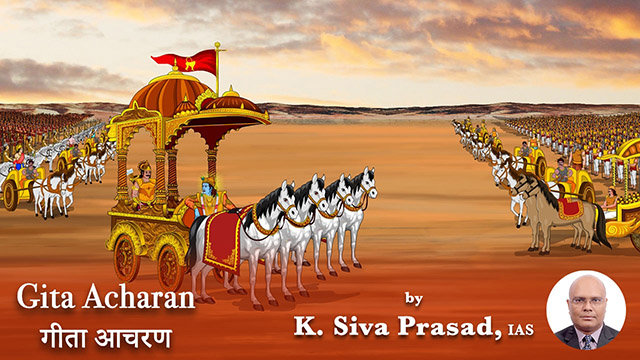
After explaining that the three 𝙜𝙪𝙣𝙖𝙨 (modes of nature) of 𝙨𝙖𝙩𝙫𝙖 , 𝙧𝙖𝙟𝙤 and 𝙩𝙖𝙢𝙤 bind the 𝙖𝙩𝙢𝙖 (soul) with the physical body, Krishna mentions about transcending these 𝙜𝙪𝙣𝙖𝙨 to become 𝙜𝙪𝙣𝙖-𝙖𝙩𝙚𝙚𝙩𝙝 or 𝙣𝙞𝙧-𝙜𝙪𝙣 (𝙨𝙖𝙣𝙨 𝙜𝙪𝙣𝙖𝙨 ). Immediately, Arjun enquires about the signs that distinguish the person who has transcended the 𝙜𝙪𝙣𝙖𝙨 ; his conduct and how does he go beyond these three 𝙜𝙪𝙣𝙖𝙨 (4.21).
Krishna says, "Illumination (symbolising 𝙨𝙖𝙩𝙫𝙖 ), activity (𝙧𝙖𝙟𝙤) and ignorance (𝙩𝙖𝙢𝙤) , he hates not when present nor longs for them when absent (14.22). He who, remaining like one unconcerned, is not disturbed by 𝙜𝙪𝙣𝙖𝙨 ; who, realising that only 𝙜𝙪𝙣𝙖𝙨 are operating throughout creation, is firm and centred in the Self" (14.23).
Firstly, this is neither attachment ( 𝙧𝙖𝙖𝙜 or 𝙖𝙖𝙨𝙖𝙠𝙩𝙞 ) nor detachment ( 𝙫𝙞𝙧𝙖𝙖𝙜 or 𝙫𝙞𝙧𝙖𝙠𝙩𝙞 ) with any manifestations of 𝙜𝙪𝙣𝙖𝙨 and Krishna earlier used 𝙫𝙚𝙚𝙩-𝙧𝙖𝙖𝙜 or 𝙖𝙣𝙖𝙖𝙨𝙖𝙠𝙩𝙞 to describe such an eternal state. Secondly, in a similar circumstance, Krishna earlier advised us to drop hatred but not 𝙠𝙖𝙧𝙢𝙖𝙨 (actions). Thirdly, it is making 𝙜𝙪𝙣𝙖𝙨 as slaves. When we need to sleep, summon 𝙩𝙖𝙢𝙖𝙨 ; use 𝙧𝙖𝙟𝙖𝙨 when we need to do some activity; 𝙨𝙖𝙩𝙫𝙖 to learn. It is moving from a state of slavery to the master of 𝙜𝙪𝙣𝙖𝙨 .
At that state, one realises that there is no 𝙠𝙖𝙧𝙩𝙝𝙖 (doer) other than the three 𝙜𝙪𝙣𝙖𝙨 . It is the interaction between them that results in 𝙠𝙖𝙧𝙢𝙖 throughout creation but not because of us or someone else.
One path is to detach 𝙠𝙖𝙧𝙢𝙖 from 𝙠𝙖𝙧𝙢𝙖-𝙥𝙝𝙖𝙡 (fruits of action) by realising that 𝙠𝙖𝙧𝙢𝙖-𝙥𝙝𝙖𝙡 depends on many factors. The second is to detach 𝙠𝙖𝙧𝙩𝙝𝙖 from 𝙠𝙖𝙧𝙢𝙖 realising that the three 𝙜𝙪𝙣𝙖𝙨 are the real 𝙠𝙖𝙧𝙩𝙝𝙖 . Both paths lead to 𝙣𝙞𝙧-𝙖𝙝𝙖𝙣𝙠𝙖𝙖𝙧 (sans the feeling of I am doer). One is thus centered in the Self and Krishna described them as 𝙖𝙩𝙢𝙖-𝙧𝙖𝙢𝙖𝙣 or 𝙣𝙞𝙩𝙮𝙖-𝙩𝙧𝙞𝙥𝙩𝙝 .

